Determination of β2-Agonist Residues in Meat Samples by Gas Chromatography-Mass Spectrometry with N-Doped Carbon Dots in Molecular Sieves
Abstract
:1. Introduction
2. Materials and Methods
2.1. Reagents and Materials
2.2. Apparatus
2.3. Preparation of the ZMS@N-CQDs
2.4. Sample Preparation Procedure
2.5. Extraction and Elution Procedures
2.6. Adsorption Experiment
3. Results and Discussion
3.1. Characterization
3.2. Optimization of Extraction and Elution Conditions
3.3. Comparison of Adsorption Capacity
3.4. The kinetic and Isothermal Adsorption
3.4.1. Adsorption Kinetics
3.4.2. Adsorption Isotherms
3.5. Method Validation
3.6. Comparison with Other Methods
3.7. Matrix Effects
3.8. Practical Sample Analysis
4. Conclusions
Supplementary Materials
Author Contributions
Funding
Data Availability Statement
Acknowledgments
Conflicts of Interest
References
- Liu, M.; Ma, B.; Wang, Y.; Chen, E.; Li, J.; Zhang, M. Research on Rapid Detection Technology for β2-Agonists: Multi-Residue Fluorescence Immunochromatography Based on Dimeric Artificial Antigen. Foods 2022, 11, 863. [Google Scholar] [PubMed]
- Lv, C.Z.; Xun, Y.; Cao, Z.; Xie, J.L.; Li, D.; Liu, G.; Yu, L.; Feng, Z.M.; Yin, Y.L.; Tan, S.Z. Sensitive determination of toxic clenbuterol in pig meat and pig liver based on a carbon nanopolymer composite. Food Anal. Methods 2017, 10, 2252–2261. [Google Scholar] [CrossRef]
- Shishani, E.I.; Chai, S.C.; Jamokha, S.; Aznar, G.; Hoffman, M.K. Determination of ractopamine in animal tissues by liquid chromatography-fluorescence and liquid chromatography/tandem mass spectrometry. Anal. Chim. Acta 2003, 483, 137–145. [Google Scholar] [CrossRef]
- Wan, L.; Gao, H.; Liu, X.; Gao, S.; Zhou, L.; Wang, F.; Chen, M. Electromembrane extraction of clenbuterol from swine urine for monitoring illegal use in livestock. J. Sep. Sci. 2022, 45, 3966–3973. [Google Scholar] [CrossRef]
- Ma, Z.; Wang, Q.; Gao, N.; Li, H. Electrochemical detection of clenbuterol with gold-nanoparticles-modified porous boron-doped diamond electrode. Microchem. J. 2020, 157, 104911. [Google Scholar] [CrossRef]
- Wang, Z.L.; Zhang, J.L.; Zhang, Y.N.; Zhao, Y. Mass spectrometric analysis of residual clenbuterol enantiomers in swine, beef and lamb meat by liquid chromatography tandem mass spectrometry. Anal. Methods 2016, 8, 4127–4133. [Google Scholar] [CrossRef]
- Cai, C.; Xiang, Y.; Tian, S.; Hu, Z.; Hu, Z.; Ma, B.; Wu, P. Determination of β2-Agonist Residues in Fermented Ham Using UHPLC-MS/MS after Enzymatic Digestion and Sulfonic Resin Solid Phase Purification. Molecules 2023, 28, 2039. [Google Scholar] [CrossRef]
- Yan, K.; Zhang, H.; Hui, W.; Zhu, H.; Li, X.; Zhong, F.; Chen, C. Rapid screening of toxic salbutamol, ractopamine, and clenbuterol in pork sample by high-performance liquid chromatography-UV method. J. Food Drug Anal. 2016, 24, 277–283. [Google Scholar] [CrossRef]
- Chang, L.Y.; Chou, S.S.; Hwang, D.F. High performance liquid chromatography to determine animal drug clenbuterol in pork, beef and hog liver. J. Food Drug Anal. 2005, 13, 163–167. [Google Scholar] [CrossRef]
- Li, F.; Zhou, J.; Wang, M.; Zhang, L.; Yang, M.; Deng, L. Production of a matrix certified reference material for measurement and risk monitoring of clenbuterol in mutton. Anal. Bioanal. Chem. 2023, 415, 1487–1496. [Google Scholar] [CrossRef]
- Giannetti, L.; Ferretti, G.; Gallo, V.; Necci, F.; Giorgi, A. Analysis of beta-agonist residues in bovine hair: Development of a UPLC-MS/MS method and stability study. J. Chromatogr. B 2016, 1036–1037, 76–83. [Google Scholar]
- Zhao, L.; Zhao, J.; Huangfu, W.G.; Wu, Y.L. Simultaneous Determination of Melamine and Clenbuterol in Animal Feeds by GC-MS. Chromatographia 2010, 72, 365–368. [Google Scholar] [CrossRef]
- Pinheiro, I.; Jesuino, B.; Barbosa, J.; Ferreira, H.; Ramos, F.; Matos, J.; da Silveira, M.I.N. Clenbuterol Storage Stability in the Bovine Urine and Liver Samples Used for European Official Control in the Azores Islands (Portugal). J. Agric. Food Chem. 2009, 57, 910–914. [Google Scholar] [CrossRef] [PubMed] [Green Version]
- Chen, X.; Wu, R.; Sun, L.; Yao, Q.; Chen, X. A sensitive solid-state electrochemiluminescence sensor for clenbuterol relying on a PtNPs/RuSiNPs/Nafion composite modified glassy carbon electrode. J. Electroanal. Chem. 2016, 781, 310–314. [Google Scholar] [CrossRef]
- Ma, F.; Li, X.; Li, Y.; Feng, Y.; Ye, B.C. High current flux electrochemical sensor based on nickel-iron bimetal pyrolytic carbon material of paper waste pulp for clenbuterol detection. Talanta 2022, 250, 123756. [Google Scholar] [CrossRef] [PubMed]
- Chunsheng, L.; Yujing, L.; Yan, Z.; Jingjing, L.; Junhua, L.; Meng, W.; Haiyan, L.; Zhencai, Y. Preparation of an anti-formoterol monoclonal antibody for indirect competitive ELISA detection of formoterol in urine and pork samples. Anal. Methods 2018, 10, 548–553. [Google Scholar] [CrossRef]
- Li, Y.; Zhang, H.; Cui, Z.; Liu, S.; Xu, J.; Jia, C.; Chen, Y.; Wang, L.; Sun, J.; Zhang, D.; et al. Chemical staining enhanced Enzyme-linked immunosorbent assay for sensitive determination of Clenbuterol in food. Food Chem. 2023, 400, 134012. [Google Scholar] [CrossRef]
- Guo, Q.; Peng, Y.; Zhao, X.; Chen, Y. Rapid Detection of Clenbuterol Residues in Pork Using Enhanced Raman Spectroscopy. Biosensors 2022, 12, 859. [Google Scholar] [CrossRef] [PubMed]
- Peng, F.; Li, B.; Sun, S.; Mi, F.; Wang, Y.; Hu, C.; Geng, P.; Pang, L.; Li, J.; Guan, M. A novel fluorescence internal filtration immunoassay for the detection of clenbuterol. Eur. Food. Res. Technol. 2022, 248, 415–426. [Google Scholar] [CrossRef]
- Fan, J.; Cai, Y.; Yan, Z.; Li, Y.; Yao, X. Determination of polycyclic aromatic hydrocarbons in Chinese herbal medicines by gas chromatography-mass spectrometry with graphene-functionalized nickel foam. J. Chromatogr. A 2023, 1694, 463904. [Google Scholar] [CrossRef]
- Wu, C.; Ning, X.; Chen, X.; Ma, J.; Zhao, Q.; Zhao, L.; Zhu, G.; Shi, S. Multi-functional porous organic polymers for highly-efficient solid-phase extraction of β-agonists and β-blockers in milk. RSC Adv. 2021, 11, 28925–28933. [Google Scholar] [CrossRef] [PubMed]
- Lin, Y.P.; Lee, Y.L.; Hung, C.Y.; Huang, W.J.; Lin, S.C. Determination of multiresidue analysis of β-agonists in muscle and viscera using liquid chromatograph/tandem mass spectrometry with Quick, Easy, Cheap, Effective, Rugged, and Safe methodologies. J. Food Drug Anal. 2017, 25, 275–284. [Google Scholar] [CrossRef] [PubMed]
- Behbahani, M.; Bagheri, S.; Omidi, F.; Amini, M.M. An amino-functionalized mesoporous silica (KIT-6) as a sorbent for dispersive and ultrasonication-assisted micro solid phase extraction of hippuric acid and methylhippuric acid, two biomarkers for toluene and xylene exposure. Microchim. Acta 2018, 185, 505–512. [Google Scholar] [CrossRef]
- Parvizi, S.; Behbahani, M.; Esrafili, A. Preconcentration and ultra-trace determination of hexavalent chromium ions using tailor-made polymer nanoparticles coupled with graphite furnace atomic absorption spectrometry: Ultrasonic assisted-dispersive solid-phase extraction. New J. Chem. 2018, 42, 10357–10365. [Google Scholar]
- Salem, A.A.; Wasfi, I.; Al-Nassib, S.S.; Allawy Mohsin, M.; Al-Katheeri, N. Determination of Some β-Blockers and β2-Agonists in Plasma and Urine Using Liquid Chromatography-tandem Mass Spectrometry and Solid Phase Extraction. J. Chromatogr. Sci. 2017, 55, 846–856. [Google Scholar] [CrossRef]
- Villa, C.C.; Galus, S.; Nowacka, M.; Magri, A.; Petriccione, M.; Gutiérrez, T.J. Molecular sieves for food applications: A review. Trends Food Sci. Technol. 2020, 102, 102–122. [Google Scholar] [CrossRef]
- ALOthman, Z.A. A Review: Fundamental Aspects of Silicate Mesoporous Materials. Materials 2012, 5, 2874–2902. [Google Scholar]
- Liu, X.; Guo, Y.; Zhang, C.; Huang, X.; Ma, K.; Zhang, Y. Preparation of Graphene Oxide/4A Molecular Sieve Composite and Evaluation of Adsorption Performance for Rhodamine B. Sep. Purif. Technol. 2022, 286, 120400. [Google Scholar] [CrossRef]
- Yu, H.; Shi, R.; Zhao, Y.; Waterhouse, G.I.; Wu, L.Z.; Tung, C.H.; Zhang, T. Smart Utilization of Carbon Dots in Semiconductor Photocatalysis. Adv. Mater. 2016, 28, 9454. [Google Scholar] [CrossRef]
- Ahmad, A.; Shahraki, H.S.; Shakeel, N.; Bushra, R. Cynodon dactylon derived fluorescent N-doped carbon dots: Implications of photocatalytic and biological applications. Surf. Interfaces 2023, 38, 102812. [Google Scholar]
- Zhang, H.; Liu, K.; Liu, J.; Wang, B.; Li, C.; Song, W.; Li, J.; Huang, L.; Yu, J. Carbon Dots-in-Zeolite via In-Situ Solvent-Free Thermal Crystallization: Achieving High-Efficiency and Ultralong Afterglow Dual Emission. CCS Chem. 2020, 2, 118–127. [Google Scholar]
- Eeshwarasinghe, D.; Loganathan, P.; Kalaruban, M.; Sounthararajah, D.P.; Kandasamy, J.; Vigneswaran, S. Removing polycyclic aromatic hydrocarbons from water using granular activated carbon: Kinetic and equilibrium adsorption studies. Environ. Sci. Pollut. Res. 2018, 25, 13511–13524. [Google Scholar] [CrossRef] [PubMed] [Green Version]
- Lv, J.; Chen, Q.; Liu, J.H.; Yang, H.S.; Wang, P.; Yu, J.; Xie, Y.; Wu, Y.F.; Li, J.R. Effective Removal of Clenbuterol and Ractopamine from Water with a Stable Al(III)-Based Metal-Organic Framework. Lnorg. Chem. 2021, 60, 1814–1822. [Google Scholar] [CrossRef] [PubMed]
- Liu, R.; Tang, X.; Xiong, R.; Li, L.; Du, X.; He, L. Simultaneous determination of fourteen β2-agonist enantiomers in food animal muscles by liquid chromatography coupled with tandem mass spectrometry. J. Chromatogr. B 2022, 1193, 123169. [Google Scholar] [CrossRef] [PubMed]
- Ar-sanork, K.; Karuwan, C.; Surapanich, N.; Wilairat, P.; Nacapricha, D.; Chaisuwan, P. Mixed mode monolithic sorbent in pipette tip for extraction of ractopamine and clenbuterol prior to analysis by HPLC-UV and UHPLC-Q ExactiveTM Plus Orbitrap MS. J. Anal. Sci. Technol. 2021, 23, 12–23. [Google Scholar] [CrossRef]
- Zhao, Y.; Feng, Z.; Li, S.; Lu, Y.; Hu, Y.; Fan, H.; Zhai, X. Preparation of Magnetic Molecularly Imprinted Polymers for Selective Recognition and Determination of Clenbuterol in Pork Samples. J. Chem. 2020, 2020, 8820262. [Google Scholar] [CrossRef]
- Wang, J.; Duan, H.L.; Fan, L.; Zhang, J.; Zhang, Z.Q. A magnetic fluorinated multi-walled carbon nanotubes-based QuEChERS method for organophosphorus pesticide residues analysis in Lycium ruthenicum Murr. Food Chem. 2021, 338, 127805. [Google Scholar] [CrossRef]
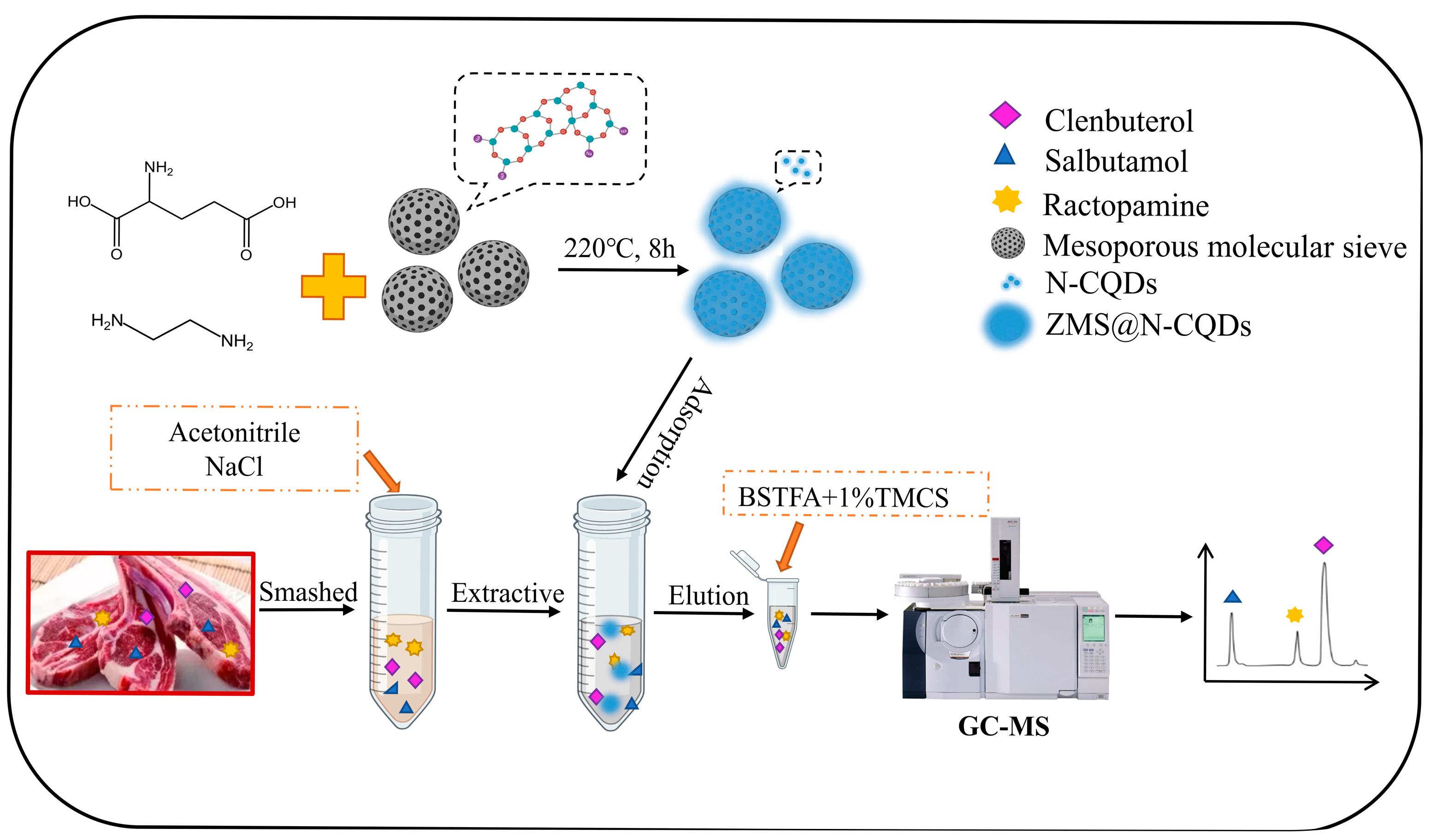

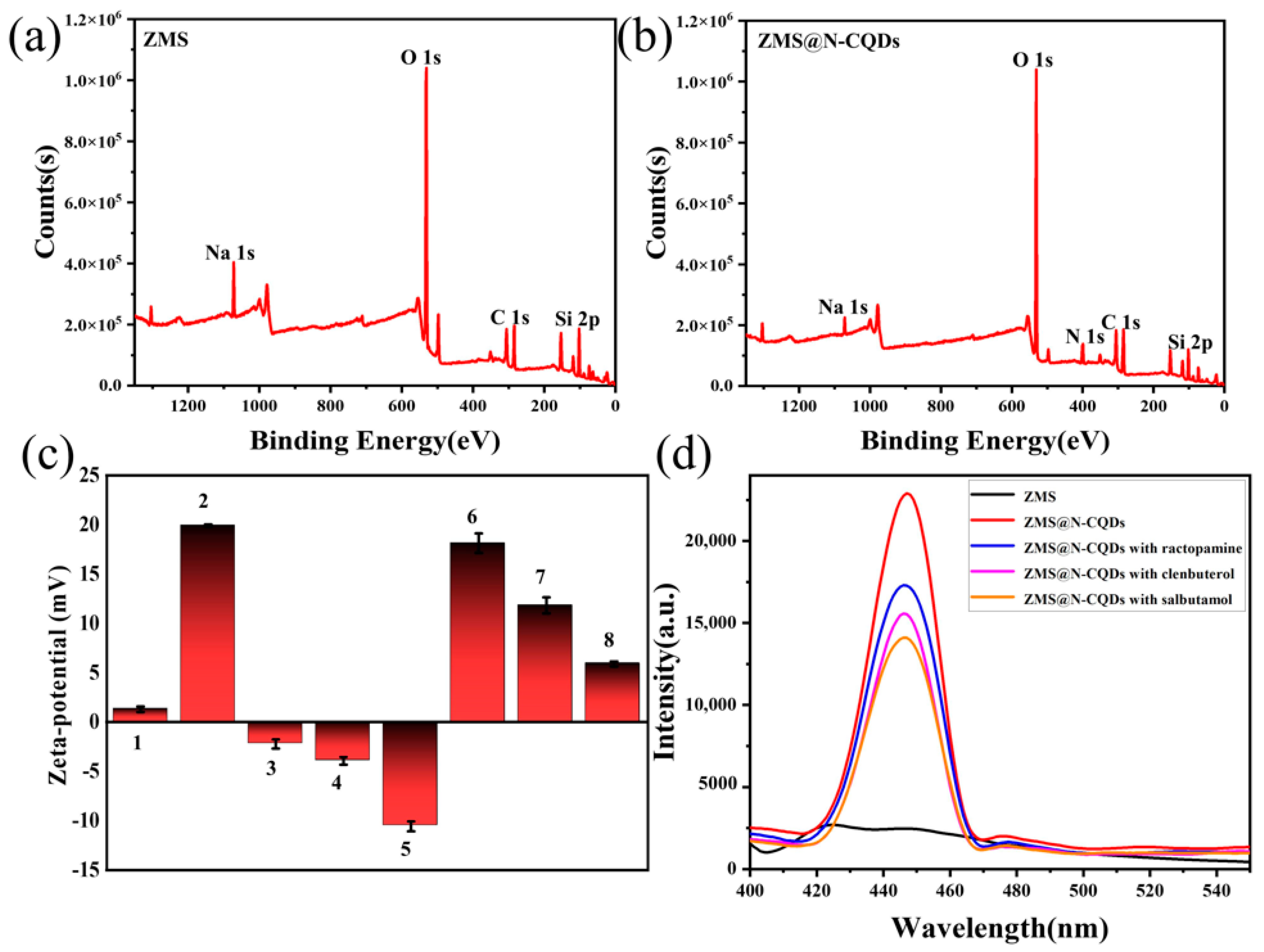
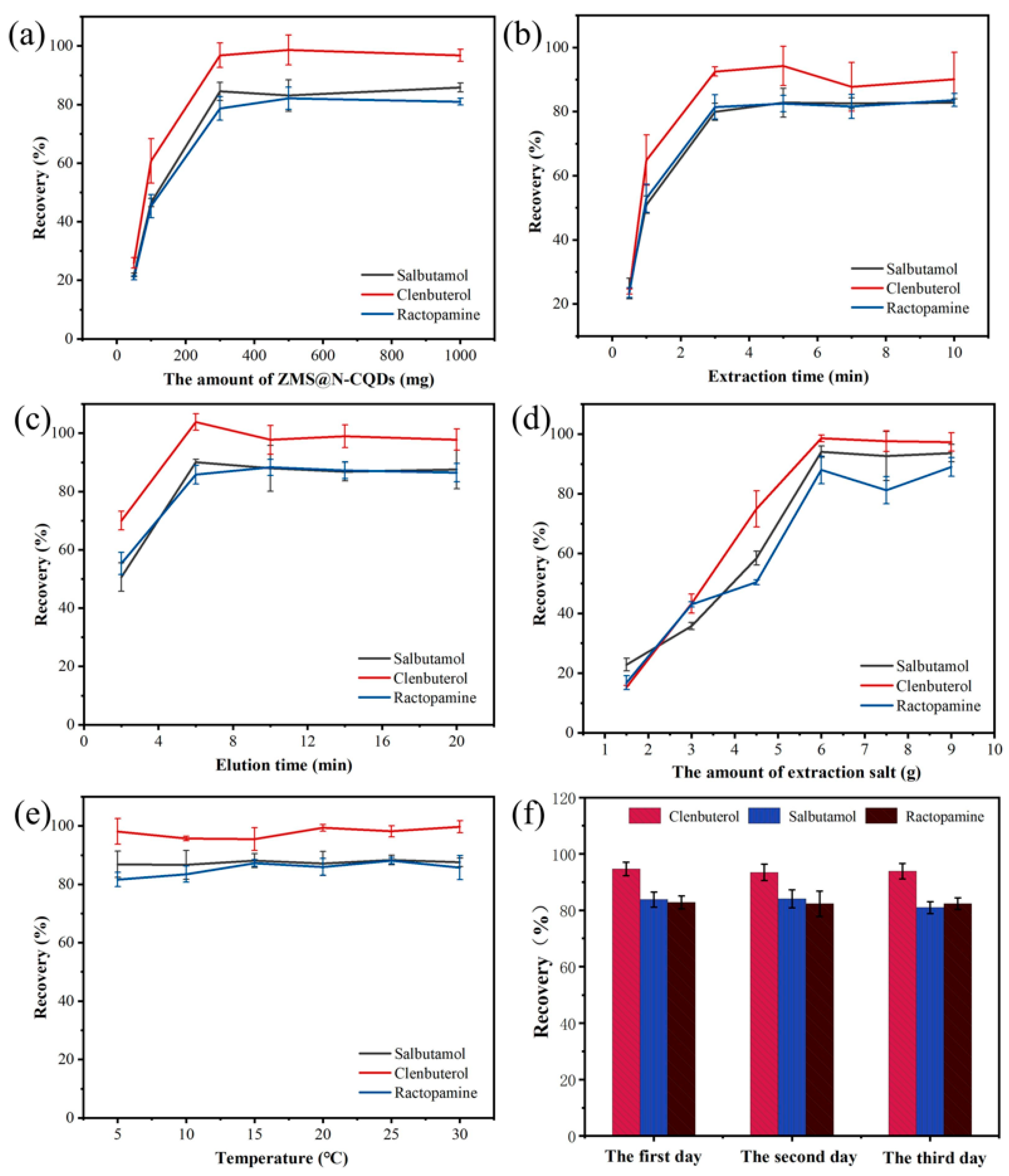
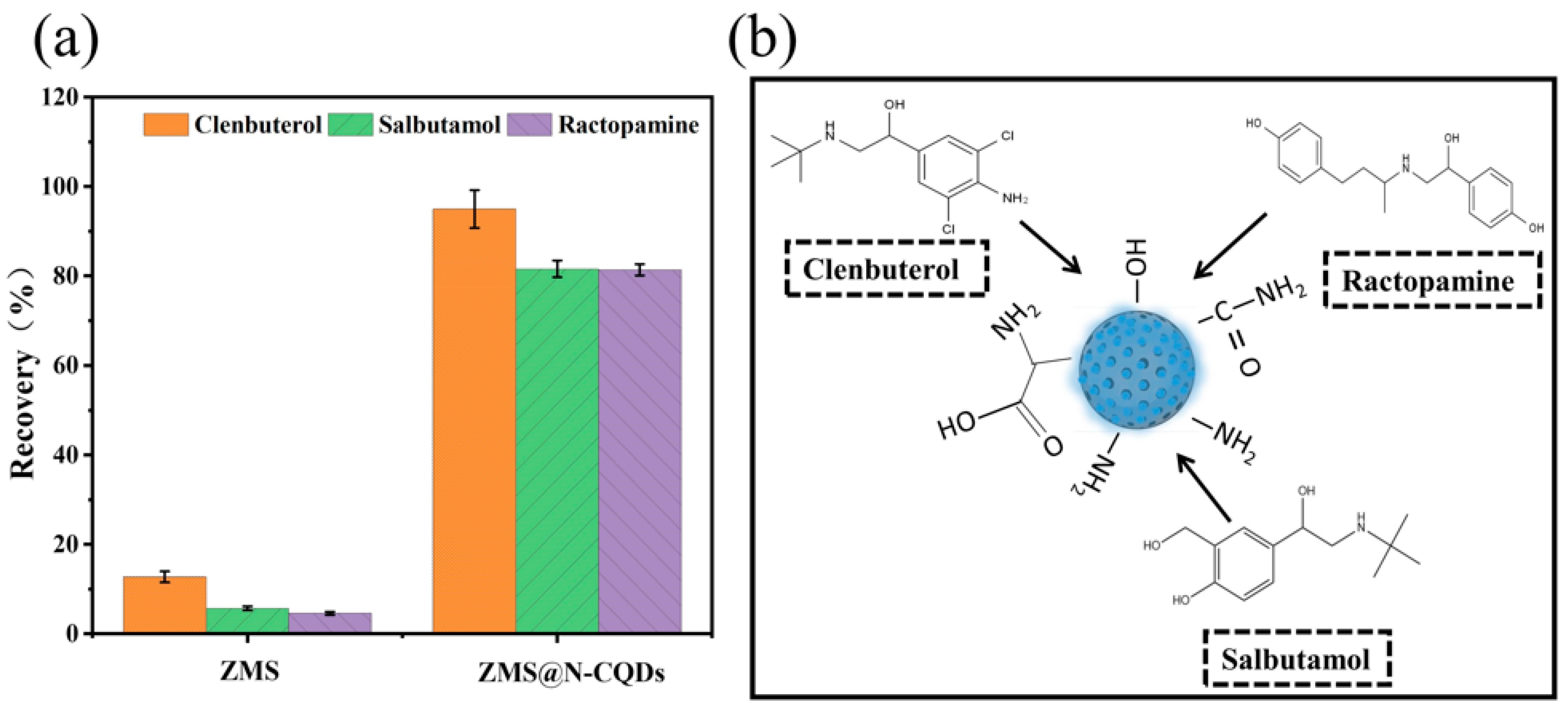
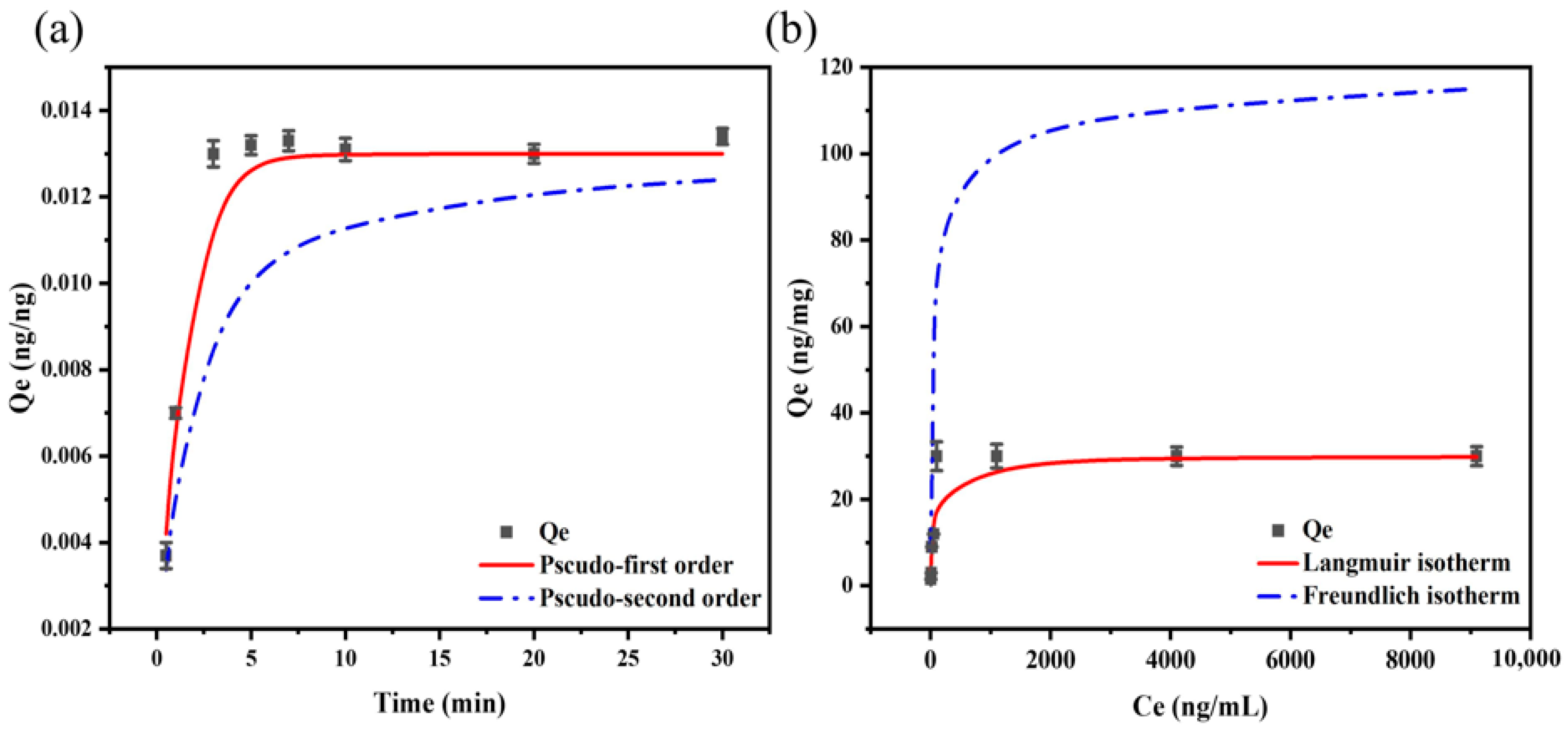
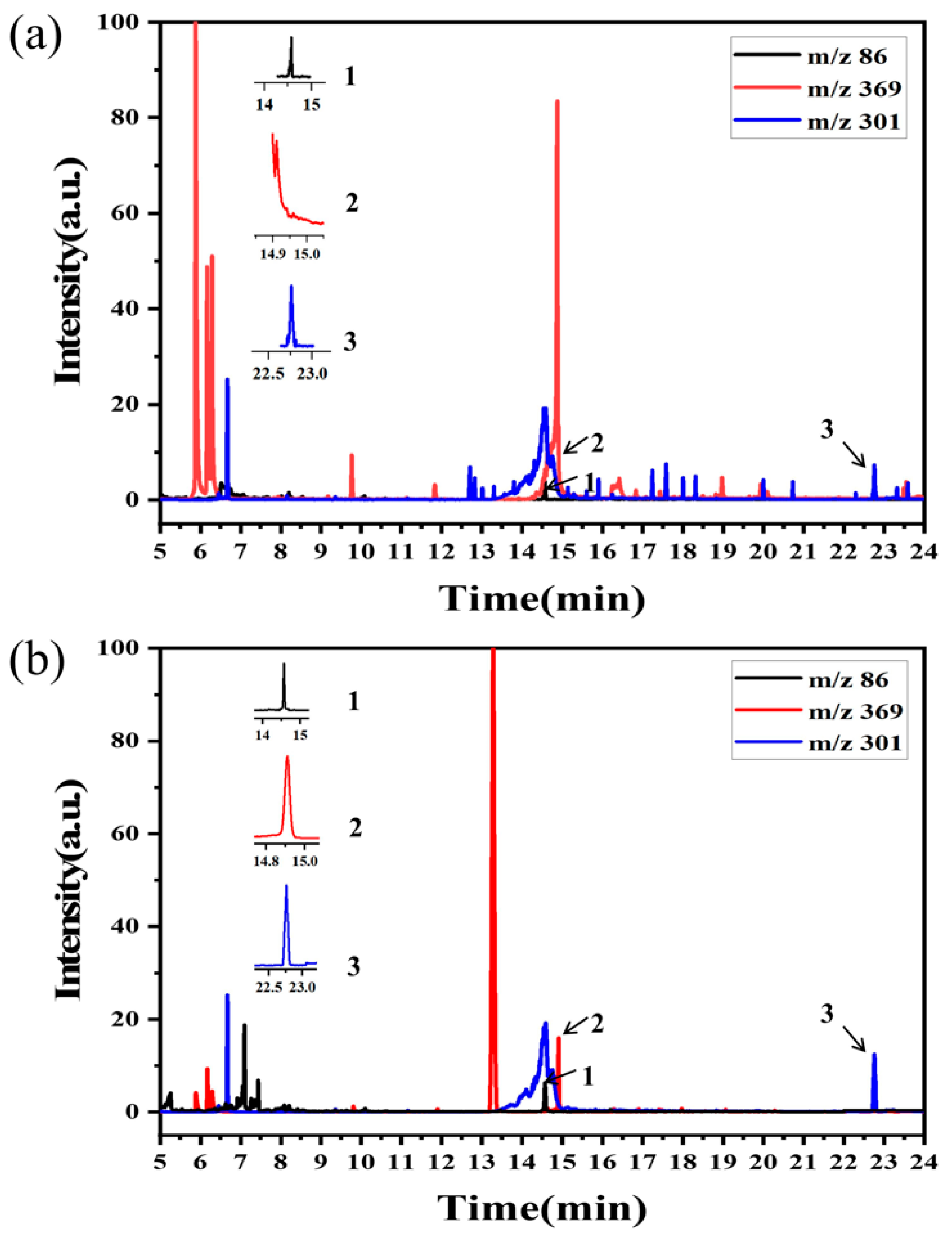
| Targets | Calibration Curve | Linear Range | R | LOD a | LOQ a | RSD (%, n = 5) |
|---|---|---|---|---|---|---|
| Clenbuterol | Y = 64.735X + 484.37 | 5–1000 | 0.9925 | 2.0 | 5.0 | 2.7 |
| Salbutamol | Y = 213.32X + 1950.7 | 2–1000 | 0.9908 | 0.7 | 2.4 | 11.9 |
| Ractopamine | Y = 202.70X + 2458.5 | 2–1000 | 0.9936 | 0.8 | 2.7 | 5.9 |
| Method | Adsorbent | Pre-Treatment Procedure | Linear Range (ng·g−1) | LOD (ng·g−1) | RSD (%) | Recoveries (%) | Ref. |
|---|---|---|---|---|---|---|---|
| Enzymatic hydrolysis, SPE-UHPLC- MS/MS | SCR a | Enzymatic hydrolysis, SPE | 0.2–5.0 | 0.1 | 4.3–10.2 | 83.0–98.0 | [7] |
| SPE-LC-MS/MS | MCX solid phase extraction cartridge | SPE | 0.2–25.0 | 0.2 | lower than 15% | 95.3–117.7 | [34] |
| micro-extraction, UHPLC-Q ExactiveTM Plus Orbitrap MS | a mixed mode monolithic material | μ-SPE | 0.8–200 | 0.19 | 2.36–4.64 | 96–106 | [35] |
| SPE-HPLC | MMIP b | SPE | 50–250 | 4.27 | 3.48–7.14 | 94.4–102.3 | [36] |
| SPE-GC-MS | ZMS@N-CQDs | SPE | 2–1000 | 0.7 | 2.7–11.9 | 79.5–97.8 | This work |
| No. | Targets | Pure Solvent | Sample Extract without Treatment | Extract Treated with the ZMS@N-CQDs | ||||||
| Y = k1X + b1 | R | Y = k2X + b2 | R | ME (%) | Y = k3X + b3 | R | ME (%) | |||
| 1 | Clenbuterol | Y = 117.73X + 3161.4 | 0.9992 | Y = 62.152X + 43611 | 0.9043 | 47.2 | Y = 90.029X + 1565.4 | 0.9963 | 23.5 | |
| 2 | Salbutamol | Y = 612.26X + 2600.3 | 0.9987 | Y = 147.26X + 27239 | 0.9638 | 75.9 | Y = 451.06X + 1547.1 | 0.9981 | 26.3 | |
| 3 | Ractopamine | Y = 456.28X + 7932.4 | 0.9975 | Y = 95.626X + 26784 | 0.8829 | 79.1 | Y = 368.75X + 8075.7 | 0.9924 | 19.2 | |
| No. | Targets | Extract Treated with PSA | Extract Treated with C18 | Extract Treated with NCD a | ||||||
| Y = k4X + b4 | R | ME (%) | Y = k5X + b5 | R | ME (%) | Y = k6X + b6 | R | ME (%) | ||
| 1 | Clenbuterol | Y = 74.274X + 1185.8 | 0.9980 | 36.9 | Y = 78.523X − 122.89 | 0.9963 | 33.3 | Y = 83.907X + 1453.7 | 0.9969 | 28.7 |
| 2 | Salbutamol | Y = 308.71X + 3945.8 | 0.9916 | 49.6 | Y = 363.03X + 6014 | 0.9905 | 40.7 | Y = 415.55X + 6610.2 | 0.9912 | 32.1 |
| 3 | Ractopamine | Y = 211.57X + 1787.6 | 0.9983 | 53.6 | Y = 253.29X + 3709.7 | 0.9921 | 44.5 | Y = 296.98X + 4637 | 0.9937 | 34.9 |
| Targets | Spiked a | Pork Sample 1 | Pork Sample 2 | Spiked a | Beef Sample 1 | Beef Sample 2 | ||||||||
| Found a | Recovery% | RSDs (%, n = 5) | Found a | Recovery% | RSDs (%, n = 5) | Found a | Recovery% | RSDs (%, n = 5) | Found a | Recovery% | RSDs (%, n = 5) | |||
| Clenbuterol | 0 | ND b | - | - | 3.85 | - | 5.2 | 0 | ND b | - | - | ND b | - | - |
| 5 | 4.89 | 97.8 | 4.7 | 8.09 | 84.8 | 6.4 | 5 | 4.81 | 96.2 | 3.2 | 4.63 | 92.6 | 2.5 | |
| 10 | 9.56 | 95.6 | 1.4 | 13.32 | 94.7 | 9.7 | 10 | 9.67 | 96.7 | 4.6 | 9.54 | 95.4 | 3.1 | |
| Salbutamol | 0 | ND b | - | - | 4.44 | - | 6.3 | 0 | ND b | - | - | ND b | - | - |
| 2 | 1.63 | 81.5 | 1.6 | 6.15 | 85.5 | 5.6 | 2 | 1.74 | 87.0 | 9.3 | 1.65 | 82.5 | 1.9 | |
| 5 | 4.16 | 83.2 | 2.3 | 8.48 | 80.8 | 6.4 | 5 | 4.37 | 87.4 | 8.2 | 4.22 | 84.4 | 2.3 | |
| Ractopamine | 0 | ND b | - | - | ND b | - | - | 0 | ND b | - | - | ND b | - | - |
| 2 | 1.67 | 83.5 | 1.3 | 1.65 | 82.5 | 7.8 | 2 | 1.69 | 84.5 | 5.7 | 1.61 | 80.5 | 3.7 | |
| 5 | 4.36 | 87.2 | 0.8 | 4.41 | 88.2 | 4.3 | 5 | 4.52 | 90.4 | 11.4 | 4.17 | 83.4 | 2.0 | |
| Targets | Spiked a | Mutton Sample 1 | Mutton Sample 2 | |||||||||||
| Found a | Recovery% | RSDs (%, n = 5) | Found a | Recovery% | RSDs (%, n = 5) | |||||||||
| Clenbuterol | 0 | ND b | - | - | ND b | - | - | |||||||
| 5 | 4.57 | 91.4 | 5.7 | 4.61 | 92.2 | 1.2 | ||||||||
| 10 | 9.23 | 92.3 | 6.1 | 9.14 | 91.4 | 0.8 | ||||||||
| Salbutamol | 0 | ND b | - | - | ND b | - | - | |||||||
| 2 | 1.60 | 80.0 | 4.8 | 1.59 | 79.5 | 2.4 | ||||||||
| 5 | 4.08 | 81.6 | 4.5 | 4.13 | 82.6 | 1.7 | ||||||||
| Ractopamine | 0 | ND b | - | - | ND b | - | - | |||||||
| 2 | 1.63 | 81.5 | 3.3 | 1.62 | 81.0 | 3.1 | ||||||||
| 5 | 4.12 | 82.4 | 3.9 | 4.15 | 83.0 | 1.5 | ||||||||
Disclaimer/Publisher’s Note: The statements, opinions and data contained in all publications are solely those of the individual author(s) and contributor(s) and not of MDPI and/or the editor(s). MDPI and/or the editor(s) disclaim responsibility for any injury to people or property resulting from any ideas, methods, instructions or products referred to in the content. |
© 2023 by the authors. Licensee MDPI, Basel, Switzerland. This article is an open access article distributed under the terms and conditions of the Creative Commons Attribution (CC BY) license (https://creativecommons.org/licenses/by/4.0/).
Share and Cite
Zhu, S.; Mou, B.; Zheng, L.; Wen, L.; Gan, N.; Zheng, L. Determination of β2-Agonist Residues in Meat Samples by Gas Chromatography-Mass Spectrometry with N-Doped Carbon Dots in Molecular Sieves. Separations 2023, 10, 429. https://doi.org/10.3390/separations10080429
Zhu S, Mou B, Zheng L, Wen L, Gan N, Zheng L. Determination of β2-Agonist Residues in Meat Samples by Gas Chromatography-Mass Spectrometry with N-Doped Carbon Dots in Molecular Sieves. Separations. 2023; 10(8):429. https://doi.org/10.3390/separations10080429
Chicago/Turabian StyleZhu, Shanshan, Binglin Mou, Liao Zheng, Luhong Wen, Ning Gan, and Lin Zheng. 2023. "Determination of β2-Agonist Residues in Meat Samples by Gas Chromatography-Mass Spectrometry with N-Doped Carbon Dots in Molecular Sieves" Separations 10, no. 8: 429. https://doi.org/10.3390/separations10080429





